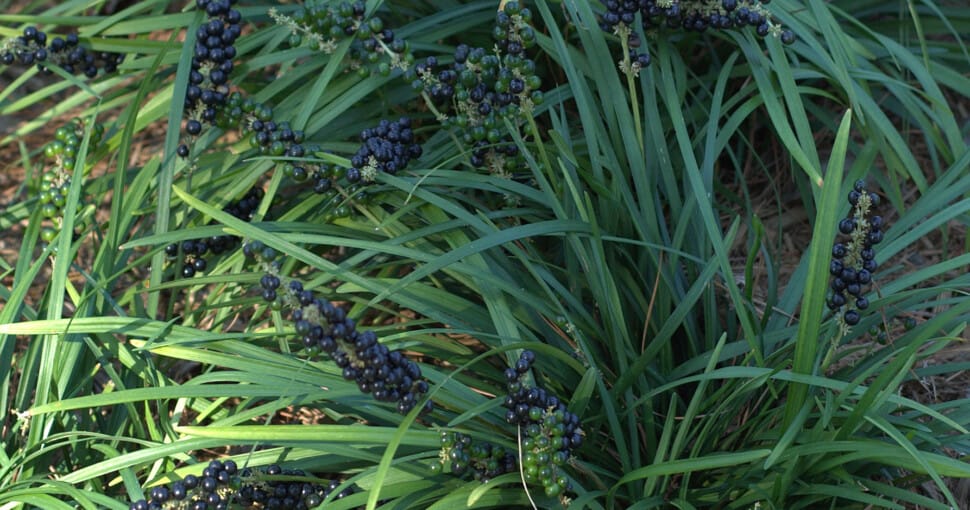Monkey grass is a favored ornamental grass for coastal gardens as it is salt tolerant. There are two main options to choose from. Liriope muscari is a taller grass and known as big blue lilyturf. The other type, liriope spicata, is a creeping groundcover.
Contents
Monkey grass is the common name for liriope which is part of the Asparagaceae family. It is also called lilyturf in some regions of the United States. While monkey grass can grow up to twenty-four inches tall, some cultivars are considerably smaller. The leaves resemble grass and may be green or variegated.
Monkey grass produces small purple flowers on a spike in summer. When the flowers wilt, they give rise to clusters of berries.
If you are wondering if any other plants resemble or look like Monkey grass, read on!
Related: 8 Plants That Look Like Lemongrass
1. Mondo Grass
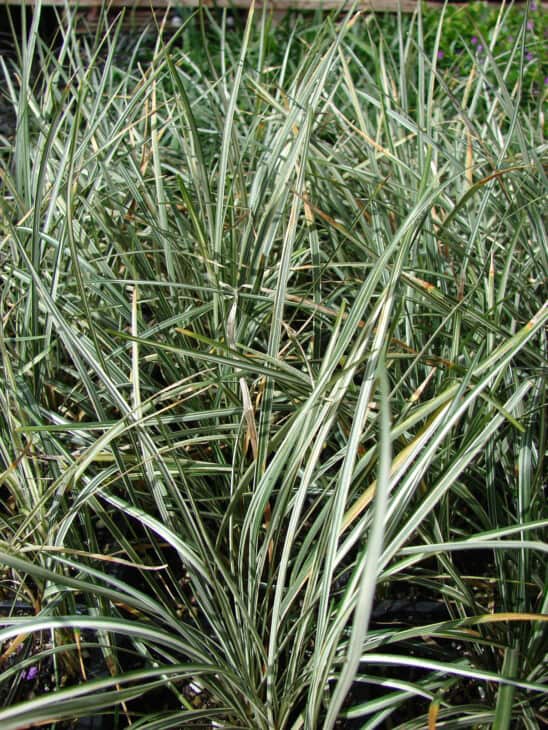
Mondo grass (Ophiopogon japonicus) is sometimes called monkey grass or dwarf lilyturf. It is a perennial grass that forms sod and is grouped in the Asparagaceae or lily plant family. Mondo grass is grown as a dense ground cover that spreads, forming clumps.
Each leaf is seven to sixteen inches long. Mondo grass varies in color according to the species and cultivar. The most common ones are dark green, but variegated colors and other hues are also available. Mondo grass looks like liriope, but it droops more and is usually a smaller plant with thinner leaves than monkey grass.
Mondo grass produces lilac, pink, or white flowers in summer. The flowers give way to attractive blue berries, similar to monkey grass, except in color. Monkey grass has black berries.
2. Aztec Grass
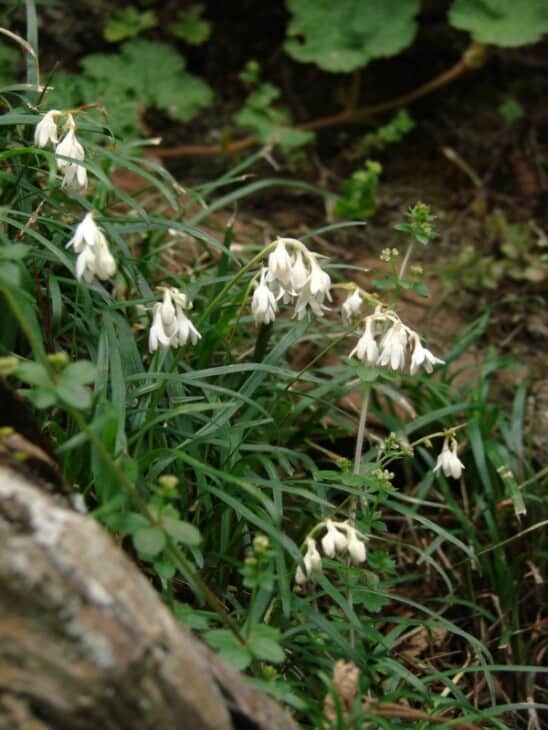
Aztec grass (Ophiopogon intermedius) is a hardy grass that grows twelve to eighteen inches tall. Aztec grass produces a dense clump of leaves and, like monkey grass, is used as an ornamental grass.
The colors vary according to the cultivar, varying from light green to darker shades. Some cultivars have heavy variegation making them a popular plant to create visual interest in a garden. It is preferable to plant Aztec grass in batches to get the best effect in a garden.
Aztec grass produces white, purple, or lavender flowers on a spike. It is semi-evergreen and grows best in full sun or partial shade. Once the flowers die, blue berries emerge.
3. Blue Gamma Grass
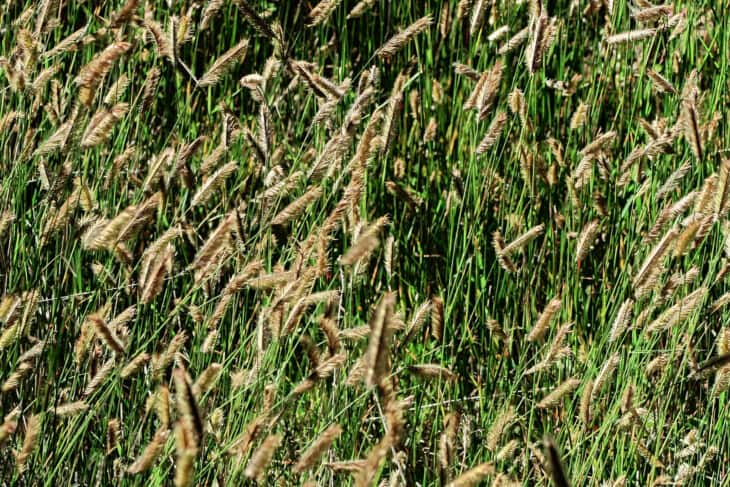
Blue gamma grass (Bouteloua gracilis) differs from monkey grass in that it is a true grass in the family Poaceae. It has green or grey-green narrow leaves that range from one to ten inches long. The total height of the plant is six to twelve inches.
Blue gamma grass produces blue seed heads, hence its common name. The seed heads can be one to two feet tall. Blue gamma is similar to monkey grass, but its leaves are finer. Municipalities use this grass to prevent erosion in sites where the soil is disturbed.
4. Plantain-Leaf Sedge
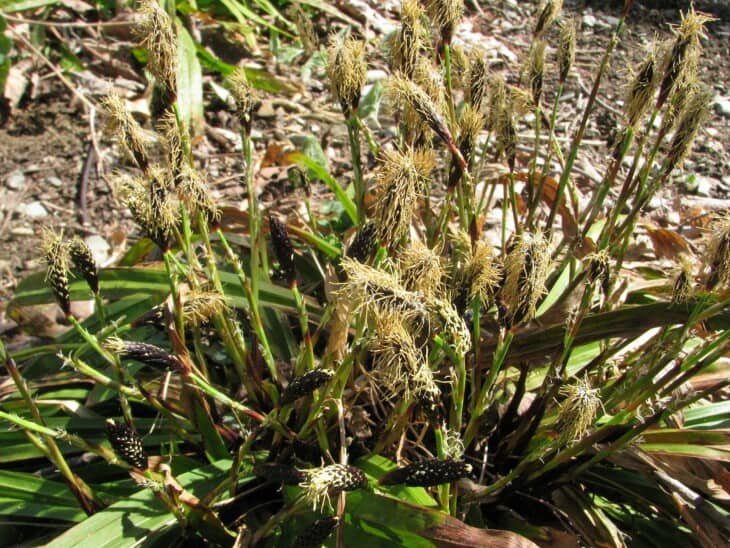
Plantain-leaf sedge (Carex plantaginea) is a plant in the Cyperaceae family. It is also known as seersucker sedge or Carex plantain. This grass is similar to monkey grass as it is low-growing, perennial and evergreen.
Plantain-leaf sedge’s bright green leaves that arch over like a waterfall make it a popular ornamental grass with gardeners. The leaves are about twelve inches long and grow from a beautiful wine-red sheath, adding color to the grass.
Plantain-leaf sedge grass produces flower spikes in spring. The flowers are purple, brown, green, or white. It grows well in moist or dry shady sites, making it a valuable plant to fill spots where plants do not usually grow.
5. Pennsylvania Sedge Grass
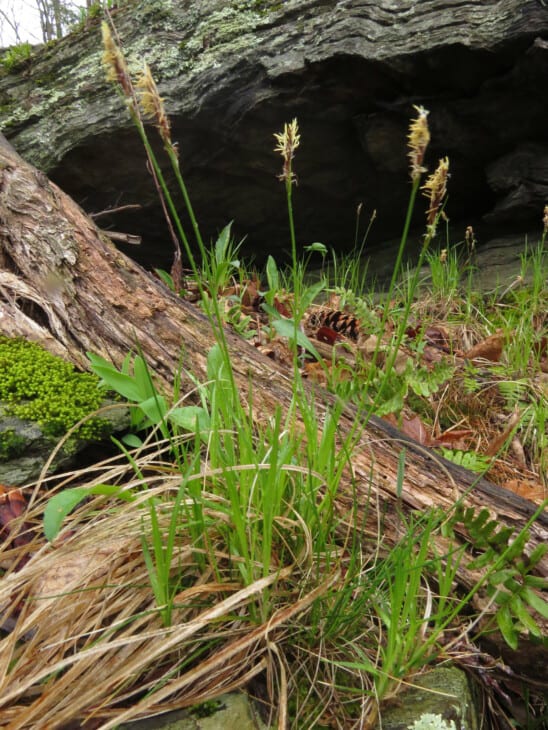
Pennsylvania sedge (Carex pensylvanica) is another grass from the sedge family that looks like monkey grass. It is also called common oak sedge and yellow sedge. It grows indigenously in the eastern regions of North America.
Pennsylvania sedge is larger than plantain-leaf sedge and monkey grass. Its leaves grow to approximately two feet in length. The plant is usually half to one foot tall. Like other sedges, it grows best in shady areas, making it a good alternative to monkey grass.
The leaves are bright green, and brownish-purple flower spikes are produced in spring. It looks best when planted in large numbers. It does not seed itself easily, making it a good choice for ecologically sensitive regions. Monkey grass can become invasive, so many gardeners prefer alternative plants.
6. Acorus Gold
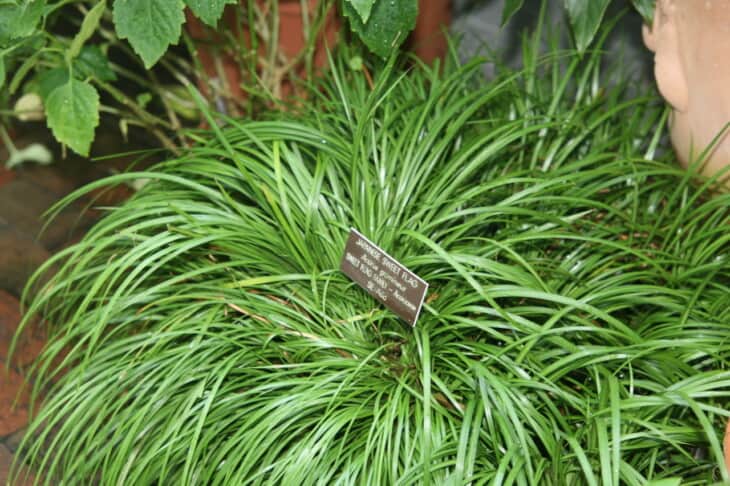
Acorus gold (Acorus gramineus) is also called Japanese sweet flag, Japanese rush, or licorice sweet flag. It is native to eastern Asia. It has a similar appearance to monkey grass but grows in water or near the water’s edge.
It has long, narrow leaves that grow to twelve inches. The leaves may be glossy and green or variegated showing yellow streaks. Acorus gold spreads easily by means of rhizomes and can cover an open area rapidly.
Acorus gold produces small greenish-yellow flowers during summer, but these are insignificant, and only the spadix that holds them attracts attention. Acorus gold has a distinctive licorice smell and taste.
7. Fiber Optic Grass
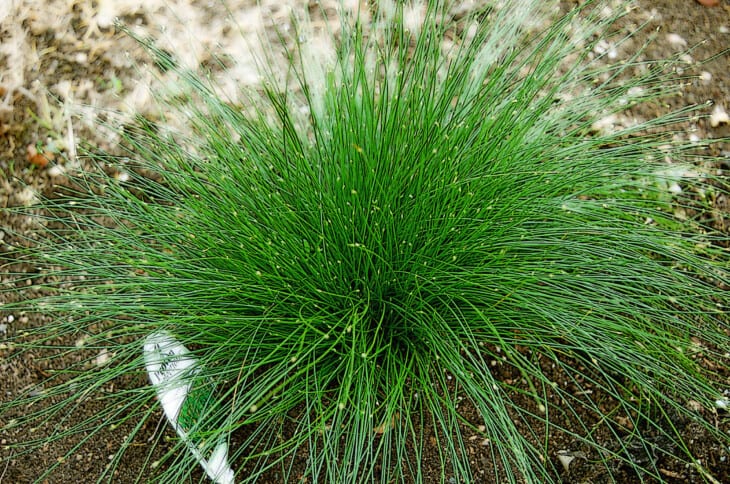
Fiber optic grass (Isolepis cernua) is a fine-leaved evergreen grass with a fountaining habit. Small, silvery flowers grow at the tip of a long stem. This gives the impression that the grass sparkles like a fiber optic light.
Fiber optic grass is not a true grass but is part of the sedge family (Cyperaceae). Like monkey grass, it is used as an ornamental grass. It grows well in areas of high moisture, making it a good choice for clay soils.
8. Blue Fescue
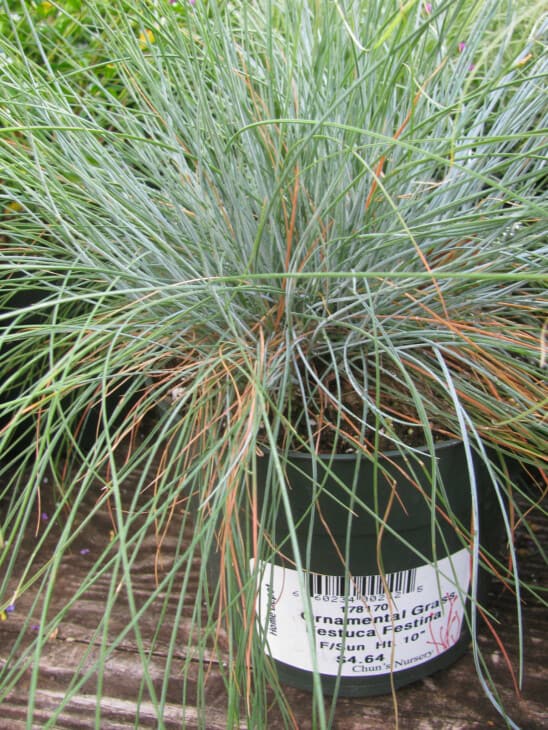
Blue fescue (Festuca glauca) is similar to liriope muscari, the taller form of monkey grass. It is a perennial grass belonging to the Poaceae family. Blue fescue grows six to twelve inches high like monkey grass.
It provides an interesting alternative color as it has silvery blue foliage with pale green flowers that become light tan as they mature.
Blue fescue grows in full sunlight like monkey grass. It can grow in semi-shade, but the leaf color is less dramatic and becomes greener. Blue fescue cultivars have varying leaf shades. Elijah Blue has light blue foliage, and Boulder Blue has silver-blue leaves. The Harz cultivar has olive-green leaves, which may develop a purplish tinge.
9. Fountain Grass
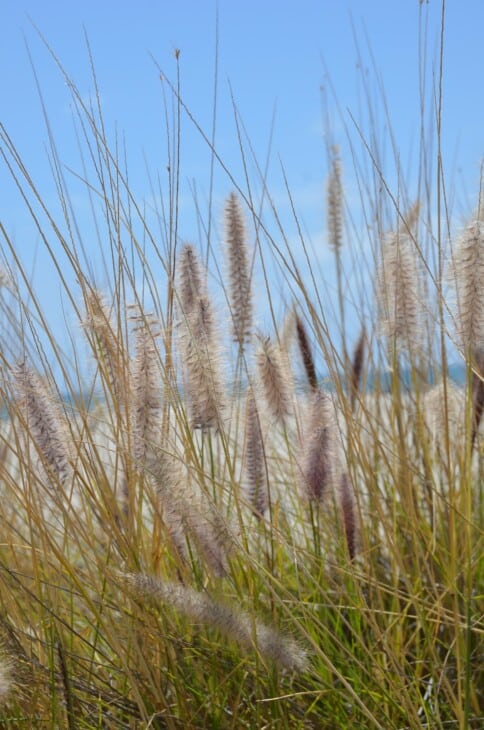
Fountain grass (Pennisetum alopecuroides) is a true perennial grass popular as an ornamental plant. It has deep green foliage in spring and summer, which resembles monkey grass. The leaves grow upwards and then arch over gracefully, giving the plant its common name.
Fountain grass develops long flower spikes in late summer. The flowers may be white, copper, pink, or purple and look like fluffy tufts. Fountain grass flowers are particularly dramatic when they are planted in large groups.
During fall, fountain grass changes to a golden brown, and eventually, in winter, the plant becomes creamy white.
10. Japanese Forest Grass
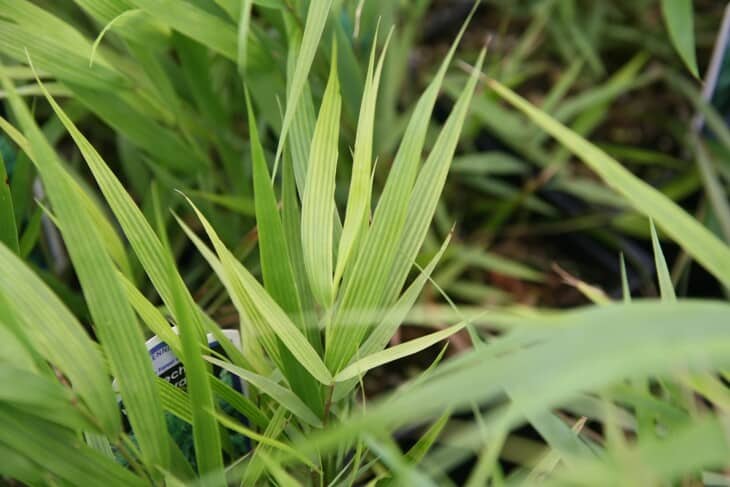
Japanese forest grass (Hakonechloa macra) is an ornamental perennial grass similar to monkey grass. Unlike monkey grass, Japanese forest grass grows well in moist shady areas.
It has long green or yellow leaves that cascade down forming a rounded mound that adds visual interest and texture to a garden. The color of the leaves is determined by their position. The leaves are lime green if Japanese forest grass is planted in deep shade. The leaves are golden yellow in dappled shade, and in full sun, they fade to a creamy white.
This grass is slow-growing and does not spread easily. It dies down during winter and reappears in spring.

